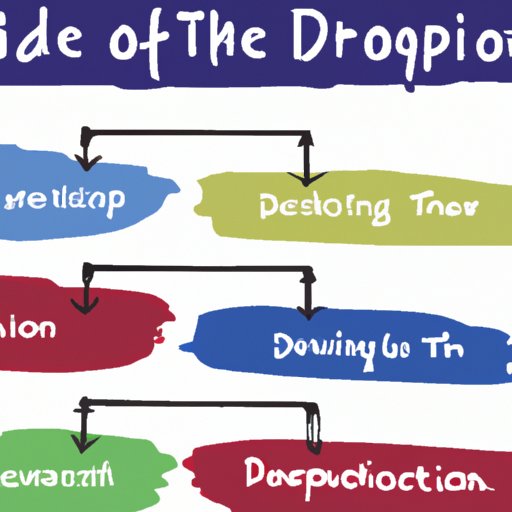Introduction
Making decisions is a part of life. From choosing a college major to investing in stocks, our lives are filled with decisions big and small. But what does it mean to make a decision? And what are the steps of decision making? This article will explore these questions and more as we dive into the process of decision making.
Definition of Decision Making
Decision making is the process of selecting a course of action from among multiple alternatives. It involves problem solving, goal setting, and evaluation of options. Throughout the decision-making process, you must weigh the pros and cons of each option and determine which one best meets your needs or goals.
Overview of the Steps of Decision Making
The steps of decision making can be broken down into six stages: identifying the problem, defining your goals, gathering information, analyzing options, making a decision, and implementing and evaluating the decision.

Outlining the Process: Breaking Down the Steps of Decision Making
Step 1: Identifying the Problem
The first step in the decision-making process is to identify the problem. Take some time to think about the issue at hand, what caused it, and what needs to be done to solve it. Ask yourself questions such as “What do I need to decide?” and “What are the consequences of this decision?” Once you have identified the problem, you can move on to the next step.
Step 2: Defining Your Goals
The second step is to define your goals. What do you want to achieve by making this decision? Consider both short-term and long-term goals, and make sure they are realistic and achievable. This will help you narrow down your options and make the decision-making process easier.
Step 3: Gathering Information
The third step is to gather information. Research the topic and consider the different perspectives. Don’t forget to consult with experts and seek advice from people who have experience in the area. This will help you understand the issue better and make an informed decision.
Step 4: Analyzing Options
The fourth step is to analyze your options. Weigh the pros and cons of each option and determine which one best meets your needs or goals. Consider factors such as cost, time, and potential risks. This will help you narrow down your choices and make the decision easier.
Step 5: Making a Decision
The fifth step is to make a decision. Once you have identified the problem, defined your goals, gathered information, and analyzed your options, it’s time to make a decision. Choose the option that best meets your needs and goals, and commit to it. Keep in mind that there is no such thing as a perfect decision; all decisions involve trade-offs.
Step 6: Implementing and Evaluating the Decision
The sixth and final step is to implement the decision and evaluate its results. Take action and follow through on your decision. Monitor the results and adjust as needed. Evaluate the outcome and consider what you would do differently in the future.

Exploring the Benefits and Challenges of Decision Making
Benefits of Decision Making
Decision making can bring many benefits, such as increased confidence, improved problem-solving skills, and greater control over your life. Making decisions helps you develop skills such as critical thinking and risk assessment, which can be useful in other areas of life. It also gives you a sense of ownership and responsibility for your actions.
Challenges of Decision Making
Decision making can also present challenges. It can be difficult to know if you are making the right decision, and even when you do make the right decision, there may be unforeseen consequences. Additionally, decision making can be stressful, especially when there are multiple options or when the stakes are high. It’s important to manage your stress levels and take breaks to avoid burnout.
Analyzing Different Types of Decisions and the Steps Involved
Short-Term Decisions
Short-term decisions are decisions that have immediate consequences. Examples of short-term decisions include deciding what to eat for dinner or whether to buy a new car. The steps of decision making for short-term decisions are similar to those for long-term decisions, with one key difference: the decision-making process should be shorter and simpler due to the shorter timeframe.
Long-Term Decisions
Long-term decisions are decisions that have long-term consequences. Examples of long-term decisions include deciding whether to go back to school or whether to invest in stocks. The steps of decision making for long-term decisions should be more thorough and comprehensive, as the consequences of these decisions will be felt for a longer period of time.

Examining the Role of Emotions in Decision Making
How Emotions Affect Decision Making
Emotions play an important role in decision making. They can influence our judgment and lead us to make decisions that we later regret. It’s important to be aware of your emotional state and recognize how it might affect your decision-making process. For example, if you’re feeling anxious or overwhelmed, it may be difficult to make a clear and rational decision.
Managing Emotional Responses
It’s important to manage your emotional responses so that they don’t interfere with your decision-making process. Take time to recognize your feelings and consider how they might be influencing your decisions. If necessary, take a break or talk to someone to get a different perspective. This will help you make informed and rational decisions.
Understanding How to Make Optimal Decisions
Thinking Critically
Thinking critically is an important skill when it comes to decision making. It involves examining the facts, considering different perspectives, and questioning assumptions. Taking the time to think critically can help you make better decisions and avoid costly mistakes.
Considering Multiple Perspectives
When making decisions, it’s important to consider multiple perspectives. Talk to others and get their opinions on the issue. This will help you gain insight into different points of view and make a more balanced decision.
Applying the Steps of Decision Making to Real-Life Examples
Example 1: Choosing a College Major
Choosing a college major is a big decision. To make the best decision, you should follow the steps of decision making. First, identify the problem: what major should you choose? Next, define your goals: what do you want to achieve by choosing a major? Then, gather information: research different majors and talk to people in the field. After that, analyze your options: weigh the pros and cons of each major and decide which one best meets your needs and goals. Finally, make a decision and commit to it. Be sure to evaluate the results and adjust as needed.
Example 2: Purchasing a Home
Purchasing a home is another big decision. To make the best decision, you should follow the steps of decision making. First, identify the problem: what type of home should you purchase? Next, define your goals: what do you want to achieve by purchasing a home? Then, gather information: research different types of homes and consult with a real estate agent. After that, analyze your options: weigh the pros and cons of each option and decide which one best meets your needs and goals. Finally, make a decision and commit to it. Be sure to evaluate the results and adjust as needed.
Example 3: Investing in Stocks
Investing in stocks is a long-term decision. To make the best decision, you should follow the steps of decision making. First, identify the problem: what type of stocks should you invest in? Next, define your goals: what do you want to achieve by investing in stocks? Then, gather information: research different types of stocks and talk to a financial advisor. After that, analyze your options: weigh the pros and cons of each option and decide which one best meets your needs and goals. Finally, make a decision and commit to it. Be sure to evaluate the results and adjust as needed.
Conclusion
In conclusion, decision making is a process of selecting a course of action from among multiple alternatives. It involves problem solving, goal setting, and evaluation of options. The steps of decision making can be broken down into six stages: identifying the problem, defining your goals, gathering information, analyzing options, making a decision, and implementing and evaluating the decision. Decision making can bring many benefits, such as increased confidence and improved problem-solving skills. However, it can also present challenges, such as stress and uncertainty. Different types of decisions require different approaches, and emotions can play an important role in decision making. To make optimal decisions, it’s important to think critically and consider multiple perspectives. By following the steps of decision making and managing your emotions, you can make informed and rational decisions.
(Note: Is this article not meeting your expectations? Do you have knowledge or insights to share? Unlock new opportunities and expand your reach by joining our authors team. Click Registration to join us and share your expertise with our readers.)
